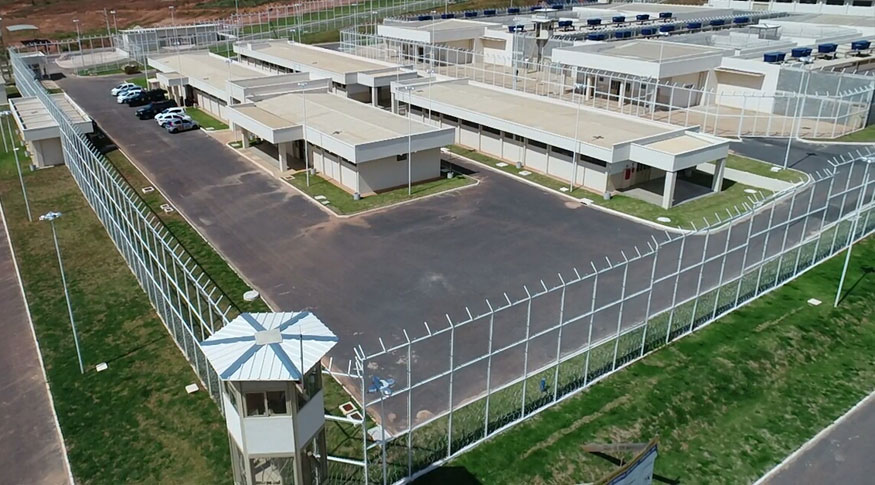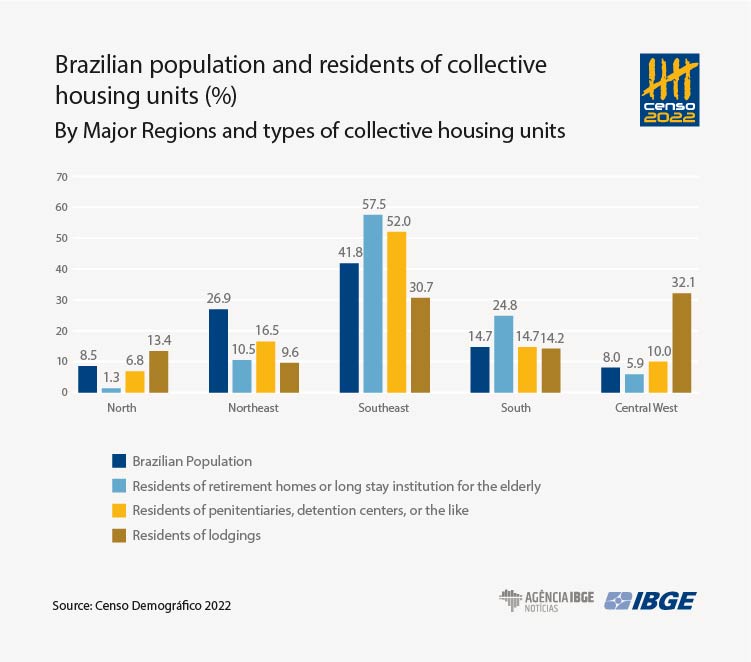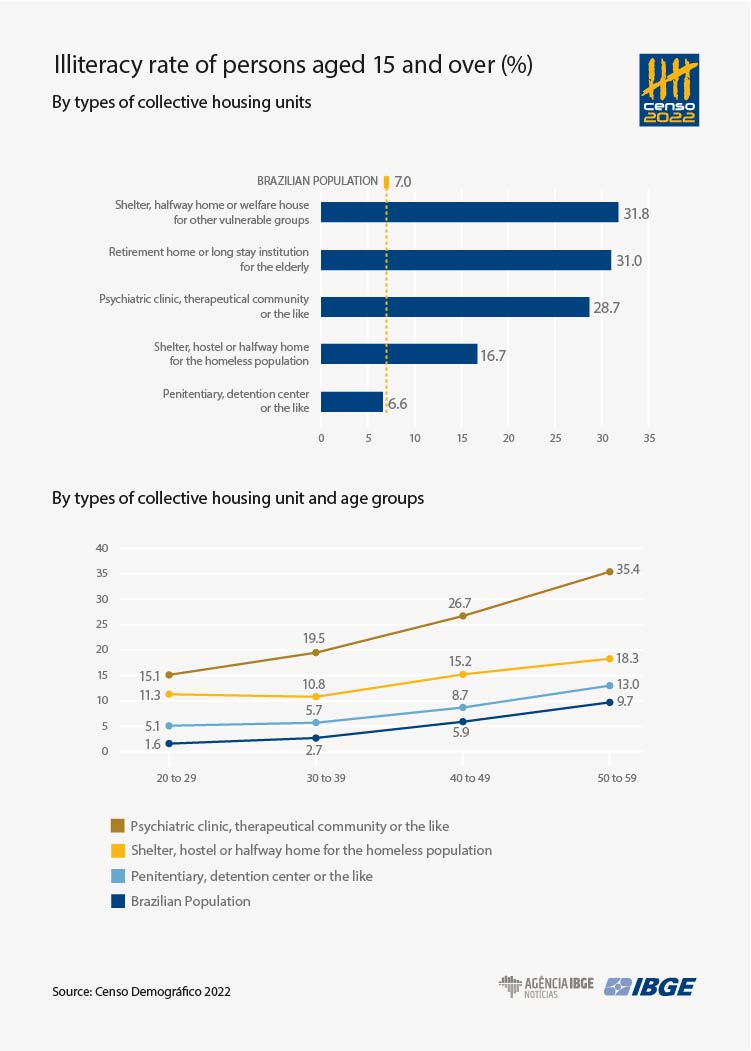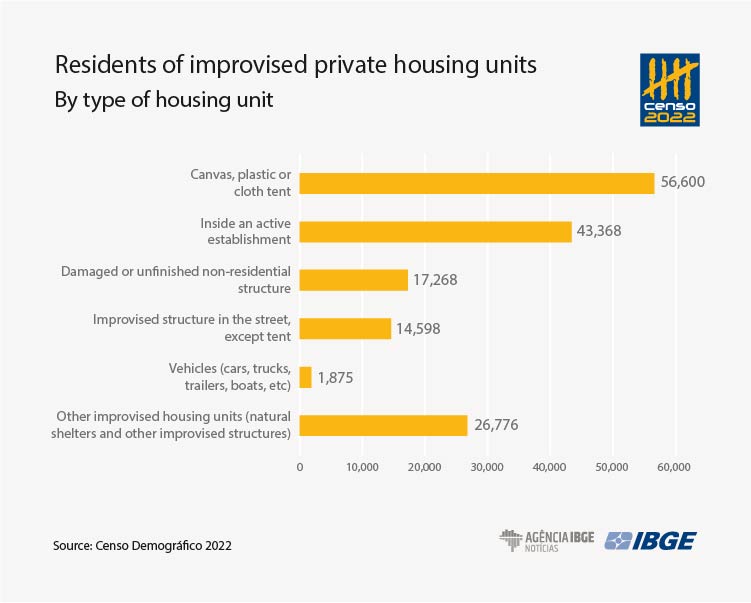2022 Census
2022 Census: 837 thousand people lived in collective housing units in Brazil
September 06, 2024 10h00 AM | Last Updated: September 10, 2024 12h25 PM
Highlights
- In 2022, 837 thousand people lived in collective housing units in the country, or 0.4% of the total population. It is the first time the IBGE presents such data from a Census, making a profile of the age, sex and literacy status of residents of these types housing unit
- The type holding the biggest number of residents was “Penitentiary, detention center or the like”, inhabited by 479 thousand persons (57.2% of the total residents in collective housing units and 0.2% of the total Brazilian population).
- In second place as for number of residents was “Retirement home or long stay institution for the elderly”, with 161 thousand persons (19.2% of the total collective housing units and 0.1% of the Brazilian population).
- In penitentiaries, 96.0% were men and 3 out of Every 4 residents were aged 20 to 39. In retirement homes women were the majority, 59.8%.
- In penitentiaries, the illiteracy rate was 6.6%, the lowest of all types of collective housing units and slightly below that observed for the Brazilian population overall (7.0%). That is due to the younger profile of residents.
- The highest illiteracy rate, on the other hand, was found in "Shelters, halfway homes or welfare houses for other vulnerable groups" (31.8%), followed by retirement homes (31.0%).
- In 2022, 160 thousand people lived in improvised private housing units.
- The type with the biggest number was "Canvas, plastic or cloth tent”, with 57 thousand residents (35.3% of the residents of improvised housing units and 0.03% of the Brazilian population). The illiteracy era of this type of improvised housing unit reached 22.3%.

In 2022, 837 thousand persons lived in collective housing units in the country, or 0.4% of the total population in the country. The type of collective housing unit with the biggest number of residents was “Penitentiary, detention center or the like”, inhabited by 479 thousand people, which corresponds to 57.2% of the total residents of collective housing units and to 0.2% of the Brazilian population.
These data come from “2022 Population Census: Types of collective, improvised, occasional-use and vacant housing units: Population results”, released today (06) by the IBGE. It is the first time the Institute presents such data from the Census and makes a profile of the age, sex and literacy status of residents of these types of housing units.
The release event will take place at 10 am at Casa Brasil IBGE, at Palácio da Fazenda, downtown Rio de Janeiro and be streamed live on Digital IBGE. Information is also available at Sidra, on the Interactive Geographic Platform (PGI) and on the Census Overview.
“For the 2022 Census, collective housing units were defined as an institution or establishment where the relationship between people living there, on the date of reference, was based on administrative subordination rules,” says Bruno Perez, analyst at the IBGE.

The second most frequent type was “Retirement home or long stay institution for the elderly”, with 161 thousand persons or 19.2% of the total residents of collective housing units and 0.1% of the Brazilian population. The Other types were “Hotel or inn” (46 thousand persons), “Lodgings” (30 thousand), “Psychiatric clinic, therapeutical community or the like” and “Shelters, halfway homes or welfare houses for other vulnerable groups” (both with 24 thousand), “ Orphanage and similar institutions” (14 thousand), “Shelter, hostel or halfway home for the homeless population” (11 thousand), “Juvenile detention centers” (8 thousand), and “Barracks or other military organization” (1 thousand). The category “Other collective housing units” had 38 thousand residents.
“Penitentiary, detention center or the like” concentrated most residents of collective housing units in all the Federation Units. By Major Region, the Southeast had 52.0% of the residents in this type of housing unit, a bigger proportion than in the Brazilian population, which was 41.8%. The Northeast, in turn, had 26.9% of the Brazilian population, but only 16.5% of the residents of penitentiaries.
The Census also showed that the South and Southeast held 82.3% of the residents of housing units of the “Retirement home” type. “This percentage can be explained due to the fact that these are the two regions with the oldest aging structures in the country,”, the researcher recalls.

In an opposite situation, the North Region, despite having 8.5% of the Brazilian population, was the home of only 1.3% of the residents of retirement homes. In the Central West, the participation of residents of “Lodgings stands out,” with 32.1% of the country - Mato Grosso, alone, had 20.3% of the residents of lodgings. “many farm Workers stay in this type of housing unit, which can indicate their predominance in that major Region. ”
In the case of “Shelter, hostel or halfway home for the homeless population”, more than half (50.6%) of the population was in São Paulo. The residents of “Shelters, halfway homes or welfare houses for other vulnerable groups” had a peculiar geographic distribution, with 34.4% in Roraima. “A situation that surely derives from the existence, in this state, of major facilities to provide temporary sheltering for the migration flow from Venezuela,” the analyst explains.
Men aged 20 to 39 were the great majority in penitentiaries
The 2022 Census also made a profile of age, sex and literacy status of residents of collective housing units. In those housing units related to depravation of freedom, men were the majority: 96.0% of the total residents of penitentiaries and 96.2% of the residents of juvenile detention facilities.
In “penitentiaries”, three out of every four workers were 20 to 39 years of age – the most common age group, 20 to 29 made up 40.7%, and the second, 30 to 30, made up 34.7%. The illiteracy rate was 6.6%, the lowest of all types of collective housing units and slightly below that for the entire Brazilian population (7.0%).
The analyst explains, however, that “It is necessary to consider this type of housing unit has a concentration of residents of younger age groups, in which illiteracy rates, in the population overall, are already very low.” That is, When the illiteracy rate is disaggregated by age groups, the residents of penitentiaries had a higher illiteracy rate than the population overall in all the age groups.

Men were also more than 75% in “Lodgings” (76.4%), "Shelters, halfway homes or welfare houses for other vulnerable groups" (79.5%), “Psychiatric clinic, therapeutical community or the like” (80.4%) and “Barracks or other military organization” (89.2%). In retirement homes, women were the majority with 59.8%. “This result is aligned with a bigger life expectancy for women and a predominance of women among the elderly population in general.”
The retirement home was the type of housing unit with one of the highest illiteracy rates (31.0%), with the exception of the age group, although residents also had high illiteracy rates in comparison with the population at a similar age: among persons aged 60 and over, the illiteracy rates in retirement homes was 30.5%, whereas for this age group in Brazil the result was 17.2%.
In 2022, 160 thousand people lived in improvised private housing units
Today’s release also presents results on improvised private housing units – located in buildings which were not exclusively used for housing, in damaged or unfinished commercial or industrial facilities, sidewalks, squares or viaducts and natural shelters, as well as moving structures (such as vehicles and tents).

The 2022 Census showed that almost 160 thousand persons lived in improvised private housing units. The type with the biggest amount was "Canvas, plastic or cloth tent", with 57 thousand residents – that is, 35.3% of the residents of improvised housing units and 0.03% of the Brazilian population. In second place was "Inside an active establishment " (43 thousand residents), followed by "Damaged or unfinished non-residential permanent structure" (17 thousand), "improvised structure in the street, except tent" (15 thousand), "Vehicles” (2 thousand). The category "Other improvised housing units" had 27 thousand residents.
It is worthy of mention that the Census is a household survey. Therefore, it does not Count the homeless population in the country. “This group of people we refer to here is not necessarily a group that can be classified as homeless population entirely. There are examples of residents of tents in rural areas, land under legal dispute, among Other examples. Likewise, there are homeless people not covered by this classification since they do not have any type of improvised housing unit, who sleep on cardboard on the street, or are facing similar conditions.”
São Paulo had the biggest number of residents for all types of improvises housing units, except for vehicles (including boats), for which Amazonas was number one. In all the types, most of the residents were men, ranging between 54.3% in “Improvised structure in the street, except tent” to 61.7% in “Vehicles”.
The illiteracy rates of residents of improvised housing units aged 15 and over were above those observed among the Brazilian population in all the types of housing units, ranging between 22.3% for those in “Canvas, plastic or cloth tent” and 9.0% in “Active establishments”.
More about the survey
The 2022 Population Census: Types of collective, improvised, occasional use or vacant housing units: Population Results presents information on the population living in collective and improvised housing units, with data disaggregated by type of housing unit, sex, and age group. Relevant information includes illiteracy rate by type of housing unit and the types of non-occupied one (for occasional use and vacant). Data are presented for Brazil, Major regions, Federation Units and, in some tables, for municipalities.




















